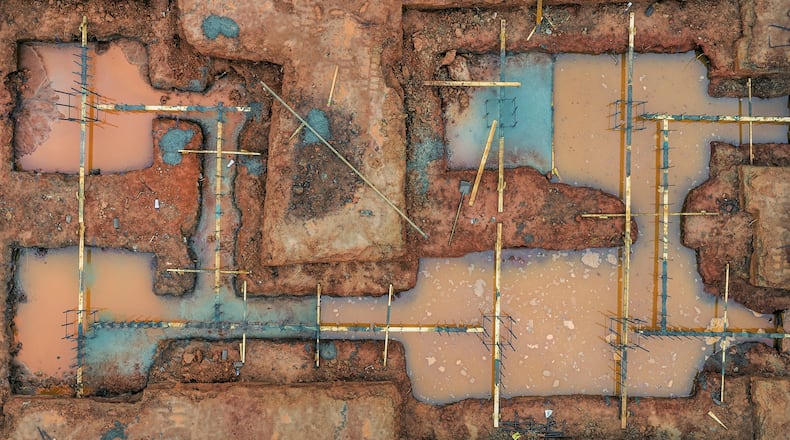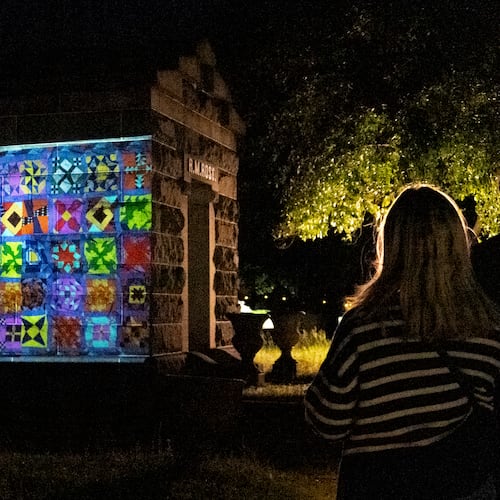This story originally was published by ArtsATL.
In a city designed around cars, driving has become part necessity and part path of discovery, at least for creative minds.
This is the case for renowned photographer Peter Essick. After spending 30 years photographing all over the world for National Geographic, he has made Atlanta his home base for visual explorations. For his latest project, “Work in Progress,” Essick has been driving around town, searching for construction sites to photograph with his drone. While construction sites seen from the side of a road may not appear visually appealing at first, a drone allows for an unexpected point of view.
Taken from above, “soil, wood, steel and concrete relate to each other in an infinite variety of order and disorder,” Essick notes at the end of the book. These endless variations are what make his photographs eye-catching and visually arresting.
Credit: Photo courtesy of Fall Line Press
Credit: Photo courtesy of Fall Line Press
Sixty-five color photographs from this series recently were published by Fall Line Press. The book includes a foreword by Dan Chapman, a noted environmental writer and journalist, who reminds us of the urgency to think deeply about our growth, alluding to the fact that “six of the nation’s 10 fastest-growing states are in the South. Nearly 40% of the country lives here.”
Drone photography has brought new creative avenues to image makers. With no horizon, the traditional rules of composition are changed, and the perspective from above flattens the world. Our spatial perception is challenged, but it also allows us to shape a different vision of a place. In that respect, Essick’s photographs of industrial sites become akin to semiabstract paintings imbued with a kaleidoscopic quality.
Credit: Photo courtesy of Fall Line Press
Credit: Photo courtesy of Fall Line Press
The book’s layout is conducive to this desired effect of disorientation. Each photograph is spread full-bleed on a double page, laying perfectly flat, without any caption or geolocation. The intention clearly is to let the viewer’s mind be immersed into the visual without the distraction of text.
It is only at the bottom of the back cover, in a tiny white font, that we are informed that “All photos were taken at construction sites in the Atlanta metro area.” But some images look as if they have been taken from a different planet.
Even though the book was printed in Spain, Essick made a conscious effort to make the process as environmentally friendly as possible by using 100% recycled paper. The result is pleasing. Unlike traditional recycled fibers, the uncoated paper feels solid and the matte surface does not look flat.
Examining urban sprawl and the increasing need for multifamily housing in metro Atlanta is another way to look at environmental issues. Maybe not in the most conventional way, but what Essick has succeeded in doing is turning industrial site imagery into a potent call to pay attention to the “power of the landscape,” as he puts it.
Credit: Photo courtesy of Fall Line Press
Credit: Photo courtesy of Fall Line Press
“My hope was that the land would come through,” he says, referring to photographer Robert Adams’ famous saying that the land can speak to us even when it has been degraded by humans.
So, as we drive around town, let us be reminded that our future does not have to be “another destructive chapter in Atlanta’s relentless storybook of sprawl,” as Chapman notes, and that there are infinite ways to reimagine what a city can be and can look like.
::
Virginie Kippelen is a photographer, multimedia producer and writer specializing in editorial and documentary projects. She has contributed to ArtsATL’s Art+Design section since 2014, writing mostly about photography. After living in the United States for more than 25 years, she still has a French accent.
Credit: ArtsATL
Credit: ArtsATL
MEET OUR PARTNER
ArtsATL (artsatl.org) is a nonprofit organization that plays a critical role in educating and informing audiences about metro Atlanta’s arts and culture. ArtsATL, founded in 2009, helps build a sustainable arts community contributing to the economic and cultural health of the city.
If you have any questions about this partnership or others, please contact Senior Manager of Partnerships Nicole Williams at nicole.williams@ajc.com.
About the Author
Keep Reading
The Latest
Featured






